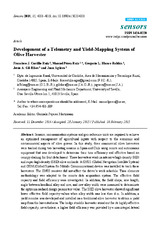Development of a Telemetry and Yield-Mapping System of Olive Harvester
Autor
Castillo-Ruiz, Francisco J.
Pérez Ruiz, Manuel
Blanco Roldán, Gregorio L.
Gil Ribes, Jesús
Agüera Vega, Juan
Editor
MDPIFecha
2015Materia
Remote data acquisitionPrecision agriculture
Effective field capacity
Field efficiency
METS:
Mostrar el registro METSPREMIS:
Mostrar el registro PREMISMetadatos
Mostrar el registro completo del ítemResumen
Sensors, communication systems and geo-reference units are required to achieve
an optimized management of agricultural inputs with respect to the economic and
environmental aspects of olive groves. In this study, three commercial olive harvesters
were tracked during two harvesting seasons in Spain and Chile using remote and autonomous
equipment that was developed to determine their time efficiency and effective based on
canopy shaking for fruit detachment. These harvesters work in intensive/high-density (HD)
and super-high-density (SHD) olive orchards. A GNSS (Global Navigation Satellite System)
and GSM (Global System for Mobile Communications) device was installed to track these
harvesters. The GNSS receiver did not affect the driver’s work schedule. Time elements
methodology was adapted to the remote data acquisition system. The effective field
capacity and field efficiency were investigated. In addition, the field shape, row length,
angle between headland alley and row, and row alley width were measured to determinate
the optimum orchard design parameters value. The SHD olive harvester showed significant
lower effective field capacity values when alley width was less than 4 m. In addition, a
yield monitor was developed and installed on a traditional olive harvester to obtain a yield
map from the harvested area. The hedge straddle harvester stood out for its highly effective
field capacity; nevertheless, a higher field efficiency was provided by a non-integral lateral canopy shaker. All of the measured orchard parameters have influenced machinery yields,
whether effective field capacity or field efficiency. A saving of 40% in effective field
capacity was achieved with a reduction from 4 m or higher to 3.5 m in alley width for SHD
olive harvester. A yield map was plotted using data that were acquired by a yield monitor,
reflecting the yield gradient in spite of the larger differences between tree yields.

